Microsoft Essential Security Pro 2013 Virus
Fake AntivirusAlso Known As: Microsoft Essential Security Pro 2013 Rogue
Get free scan and check if your device is infected.
Remove it nowTo use full-featured product, you have to purchase a license for Combo Cleaner. Seven days free trial available. Combo Cleaner is owned and operated by RCS LT, the parent company of PCRisk.com.
What is Microsoft Essential Security Pro 2013?
Microsoft Essential Security Pro 2013 is a bogus antivirus program; computer users should not trust this software. It is a scam developed by cyber criminals in the hope that computer users will purchase a license key to remove 'security infections' that are supposedly detected by Microsoft Essentials Security Pro 2013.
In fact, the process of a security scan is merely imitated, and this is an empty software shell comprising no virus definition database, scan engine, etc.
Furthermore, cyber criminals who created this scam, attempted to make its name and user interface appear as if developed by Microsoft. Microsoft, however, produces only one genuine antivirus program called Microsoft Security Essentials, and this is free of charge. Do not mistake these two programs or you may end up paying for a useless program.

When installed on a user's PC, this fake antivirus software modifies registry entries of the operating system and starts each time the computer is booted. Ignore all of the 'detection lists' delivered by this program, it is a scam and Microsoft has no connection with it.
If computer users click the 'Clean and Disinfect' button after the fake security scan, they will be advised to pay $49.95 for a 1-year license. Do not pay anything for Microsoft Essential Security Pro 2013 - it is a scam created to scare PC users into believing that their computers have serious security issues.
Microsoft Essential Security Pro 2013 is distributed using malicious websites, which commonly use fake video codecs to trick PC users into installing this rogue software on their systems. Computer users should install software updates (especially those related to video codes) from reputable sources.
If a website suggests you install additional video codecs to view a video, leave the site immediately. Fake video codecs are common distribution methods employed by cyber criminals. If you observe Microsoft Essentials Security Pro 2013 scanning your computer for security issues, do not trust this software and eliminate it from your PC as soon as possible.
Instant automatic malware removal:
Manual threat removal might be a lengthy and complicated process that requires advanced IT skills. Combo Cleaner is a professional automatic malware removal tool that is recommended to get rid of malware. Download it by clicking the button below:
DOWNLOAD Combo CleanerBy downloading any software listed on this website you agree to our Privacy Policy and Terms of Use. To use full-featured product, you have to purchase a license for Combo Cleaner. 7 days free trial available. Combo Cleaner is owned and operated by RCS LT, the parent company of PCRisk.com.
Quick menu:
- What is Microsoft Essential Security Pro 2013?
- STEP 1. Remove Microsoft Essential Security Pro 2013 using a software.
- STEP 2. Remove Microsoft Essential Security Pro 2013 using Safe Mode with Networking.
Microsoft Essential Security Pro 2013 removal:
DOWNLOAD remover for malware infections
Combo Cleaner checks if your computer is infected with malware. To use full-featured product, you have to purchase a license for Combo Cleaner. 7 days free trial available. Combo Cleaner is owned and operated by RCS LT, the parent company of PCRisk.com.
The recommended anti-spyware installation file is renamed to iexplore.exe, since Microsoft Essential Security Pro 2013 does not block execution of files with this name. If you cannot download or run the remover installation file, try to download the alternate installer
If you cannot access the Internet or use your Internet browsers (Internet explorer, FireFox, Opera, Chrome)
Click Start, then click Run. (Windows logo button on Win7/Vista)
In Windows XP, When the Run dialog appears, enter this text: www.pcrisk.com/download-spyware-remover and then press ENTER. In Windows 7 and Vista you can simply type this text directly into the search field and press ENTER (when pressing the Windows logo button)
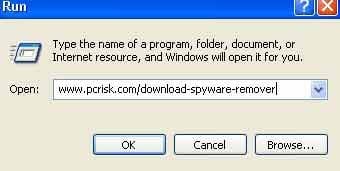

After pressing enter, the download dialogue will appear. Click Run and follow the on-screen instructions to scan your computer. If you cannot run the downloaded file, try renaming it to iexplore.exe
Microsoft Essential Security Pro 2013 manual removal:
1. Start your computer in Safe Mode. Click Start, click Shut Down, click Restart, click OK. During your computer starting process press the F8 key on your keyboard multiple times until you see the Windows Advanced Option menu, then select Safe Mode with Networking from the list.

Video showing how to start Windows 7 in "Safe Mode with Networking":
2. Open Internet Explorer, click Tools and select Internet Options. Select "Connections".

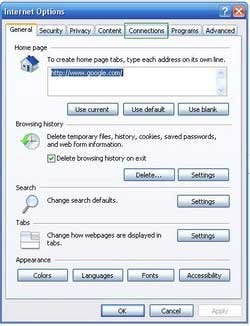
3.Click LAN settings, if 'Use a proxy server for your LAN' is checked, uncheck it and press OK.

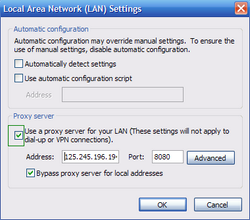
4. Download HijackThis and save it to your desktop. Some malicious programs are able to block HijackThis, so when you click the download link, in the Save dialog, rename HijackThis.exe to iexplore.exe and only then click the Save button. After saving the file to your desktop, double click it.
In the main HijackThis window click the “Do a system scan only” button. Select the following entry (place a tick at the left of the entry):
O4 - HKCU\..\Run: [WindowsSecurity] \.exe
After selecting required entry, click "Fix Checked". After this procedure you can close HijackThis and proceed to the next removal step.
5. Microsoft Essential Security Pro 2013 might modify the system Hosts file. The Hosts file is used to resolve canonical names of websites to IP addresses. When it is changed, the user may be redirected to malicious sites, despite seeing legitimate URLs in address bar. It is difficult to determine sites are genuine when the Hosts file is modified.
To fix this, please download the Microsoft Fix It tool, that restores your Hosts file to the Windows default. Run this tool when downloaded and follow the on-screen instructions. Download link below:
6. Download and install legitimate anti-spyware software to completely remove this fake antivirus program.
NOTE: Some rogue programs block the download of anti-spyware programs. If you cannot download it using the default download location, try one of the alternative download locations below:
- Location 1 (the file is renamed to "iexplore.exe", since most spyware does not block this file)
- Location 2
Summary:
The fake antivirus programs (also known as "rogue antivirus programs" or "scareware") are applications that tries to lure computer users into paying for their non-existent full versions to remove the supposedly detected security infections (although the computer is actually clean). These bogus programs are created by cyber criminals who design them to look as legitimate antivirus software. Most commonly rogue antivirus programs infiltrate user's computer using poop-up windows or alerts which appear when users surf the Internet. These deceptive messages trick users into downloading a rogue antivirus program on their computers. Other known tactics used to spread scareware include exploit kits, infected email messages, online ad networks, drive-by downloads, or even direct calls to user's offering free support.
A computer that is infected with a fake antivirus program might also have other malware installed on it as rogue antivirus programs often are bundled with Trojans and exploit kits. Noteworthy that additional malware that infiltrates user's operating system remains on victim's computer regardless of whether a payment for a non-existent full version of a fake antivirus program is made. Here are some examples of fake security warning messages that are used in fake antivirus distribution:

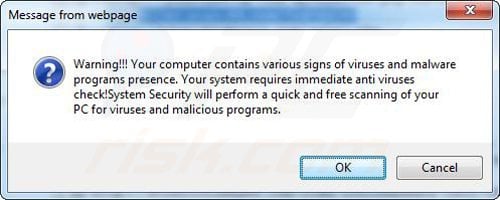
Computer users who are dealing with a rogue security software shouldn't buy it's full version. By paying for a license key of a fake antivirus program users would send their money and banking information to cyber criminals. Users who have already entered their credit card number (or other sensitive information) when asked by such bogus software should inform their credit card company that they have been tricked into buying a rogue security software. Screenshot of a web page used to lure computer users into paying for a non-existent full version of microsoft essential security pro 2013 rogue and other rogue antivirus programs:
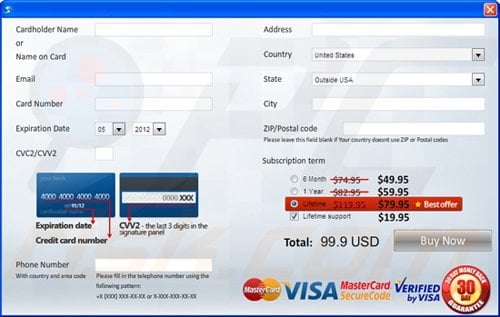
To protect your computer from microsoft essential security pro 2013 rogue and other rogue antivirus programs users should:
- Keep their operating system and all of the installed programs up-to-date.
- Use legitimate antivirus and anti-spyware programs.
- Use caution when clicking on links in social networking websites and email messages.
- Don't trust online pop-up messages which state that your computer is infected and offers you to download security software.
Symptoms indicating that your operating system is infected with a fake antivirus program:
- Intrusive security warning pop-up messages.
- Alerts asking to upgrade to a paid version of a program to remove the supposedly detected malware.
- Slow computer performance.
- Disabled Windows updates.
- Blocked Task Manager.
- Blocked Internet browsers or inability to visit legitimate antivirus vendor websites.
If you have additional information on microsoft essential security pro 2013 rogue or it's removal please share your knowledge in the comments section below.
Share:

Tomas Meskauskas
Expert security researcher, professional malware analyst
I am passionate about computer security and technology. I have an experience of over 10 years working in various companies related to computer technical issue solving and Internet security. I have been working as an author and editor for pcrisk.com since 2010. Follow me on Twitter and LinkedIn to stay informed about the latest online security threats.
PCrisk security portal is brought by a company RCS LT.
Joined forces of security researchers help educate computer users about the latest online security threats. More information about the company RCS LT.
Our malware removal guides are free. However, if you want to support us you can send us a donation.
DonatePCrisk security portal is brought by a company RCS LT.
Joined forces of security researchers help educate computer users about the latest online security threats. More information about the company RCS LT.
Our malware removal guides are free. However, if you want to support us you can send us a donation.
Donate
▼ Show Discussion